If you’re looking for help to identify black birds with red wings, this will be the best article you read today.
In this post, you will find photos, identification info, calls, songs, and all the fun information you need.
Examples of black birds with red wings include the red-winged blackbird, red-shouldered blackbird, red-winged starling, Pesquet’s parrot, red-breasted meadowlark, and many others.
Here are all 10 of them.
Table of Contents
Black Birds With Red Wings
Red-winged Blackbird
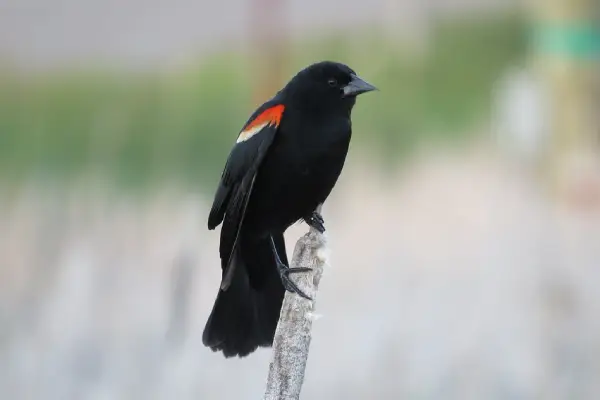
- Scientific name: Agelaius phoeniceus
- Lifespan: 2 years in the wild
- Wingspan: 12-16 in
- Color: Glossy black, red, and yellow
Red-winged blackbirds are one of the most common black birds with red wings in North America.
These tiny songbirds can weigh just 1.46 oz and measure around 6.7 inches in length.
Their scientific name “agelaios” means “gregarious,” while the “phoeniceus” means “crimson” or “red,” which perfectly describes these birds.
Male red-winged blackbirds are easily identified by their completely glossy black color and red wing epaulets that are edged in yellow. They often make red-shoulder displays and emit rich and scratchy “oak-a-lee” songs.
Source: G. McGrane, Public domain, via Wikimedia Commons
Females are smaller, streaky brown above, and paler below. They have a scolding chatter that sounds like “chit-chit-cheer-teer-teer-teerr.”
Red-winged blackbirds are one of North America’s most abundant birds as during the nonbreeding season scientists often discover flocks including over a million birds!
They are also very territorial and polygynous – a single male can have up to 10 different females making nests in his territory.
Females, on the other hand, will frequently mate with other males, and often lay eggs of mixed paternity. They will have a clutch of 3-4 pale blue-green eggs with dark streaks.
Red-winged blackbirds are common in habitats with open grassy areas, including wetlands, meadows, prairies, old fields, swamps, agricultural areas, and sparse deciduous forests.
They are omnivores and feed on insects, seeds, and grain.
Attract red-winged blackbirds to your backyard by adding black oil sunflower, hulled sunflower seeds, and mixes that contain corn, peanut hearts, sunflower seeds, and milo to your feeder.
There are over 20 subspecies of red-winged blackbirds.
Fun Fact: Despite having an average lifespan in the wild of around 2 years, the oldest ever recorded red-winged blackbird lived to be 15 years and 9 months old.
Tricolored Blackbird
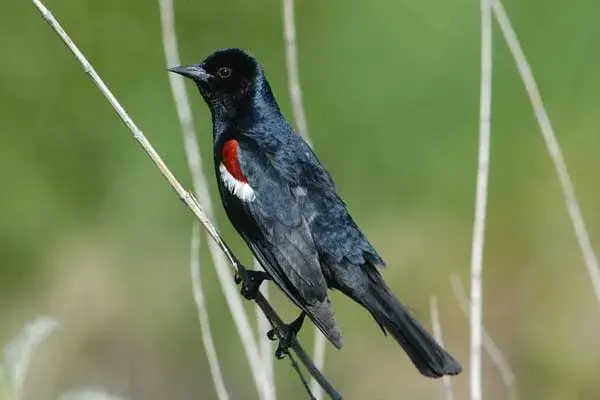
- Scientific name: Agelaius tricolor
- Lifespan: 13 years
- Wingspan: 10.2-13 in
- Color: Black, bright red, and white
Tricolored blackbirds are small black birds commonly found on the Pacific coast of North America, ranging from Northern California (USA) to upper Baja California (Mexico).
They are social passerine (perching) birds that inhabit the wetlands and grasslands of the Pacific states.
Male tricolored blackbirds can be identified by their entirely black plumage with bright red shoulders and white-colored patches.
Females are dark gray-brown and have streaked bellies and backs along with cream-colored eyebrows.
- Read More: List of birds that have eyebrows
Identify tricolored blackbirds by their nasal “kip” and sharp “check” calls and the males’ garbled “on-ke-kaaangh” song.
They are omnivores whose diet includes grasshoppers, seeds, beetles, weevils, caterpillars, and snails.
Just like their red-winged cousins, tricolored blackbirds form one of the largest colonies of any North American land bird, often including thousands of individuals.
However, their numbers have been decreasing.
According to a 1991 study made for the U.S. Fish and Wildlife Service, tricolored blackbirds were forming colonies with 300,000 birds in the 1930s. By the 1990s, no more than 10,000 birds were found in a single colony.
A more recent 2019 study discovered that from 2008 to 2017, the average colony size of these Californian songbirds decreased by approximately 40%.
Such trends have resulted in tricolored blackbirds being listed as Threatened species under the California Endangered Species Act and as Endangered by the International Union for Conservation of Nature (IUCN).
Red-shouldered Blackbird

- Scientific name: Agelaius assimilis
- Lifespan: n/a
- Wingspan: n/a
- Color: Black, red, and orange-yellow
Red-shouldered blackbirds are black birds with red wings endemic to Cuba.
Males are mostly jet black and have red and orange wing patches with pale yellow bands that are not present in females.
Red-shouldered blackbirds inhabit swamps and marshes.
They have a high-pitched and piercing song that resembles “shuh-ree-ee” and a “chut” call.
The pair will sing in a duet and this may help with pair bond formation during the pre-nesting period.
Red-shouldered blackbirds are monogamous and both sexes feed the young.
These birds nest near water, females are the ones that build the nest, lay a clutch of 2-3 eggs and incubate them.
Due to the similarity with red-winged blackbirds,red-shouldered blackbirds were previously considered their subspecies.
The main differences include vocal behavior, some aspects of breeding behavior, and plumage of nestlings.
Red-breasted Meadowlark
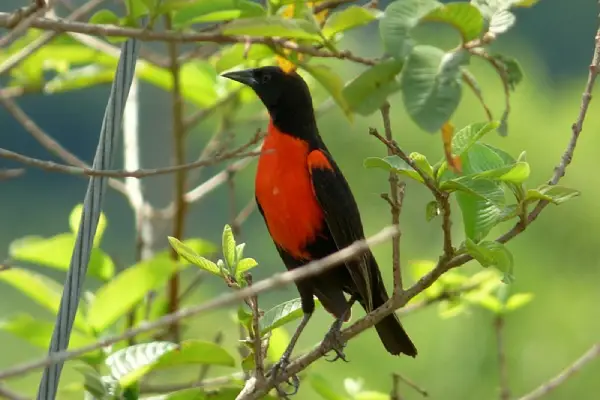
- Scientific name: Sturnella militaris
- Lifespan: n/a
- Wingspan: n/a
- Color: Black with bright red on wings and chests
Red-breasted meadowlarks are small songbirds native to Costa Rica.
They inhabit the open country, moist grasslands, pastures, and cultivation areas, especially if there is a bush or fence post for males to perch.
Male red-breasted meadowlarks are all-black and have bright red wing shoulders, throats, breasts, and upper bellies. Females are brown mottled and streaked.
To identify red-breasted meadowlarks in nature, you should listen for several metallic chips followed by a dissonant buzz. As part of their courtship ritual, males will also sing a wheezing song that sounds like “ti-ti-pee-pee-KWAAAA“.
Source: Niels Krabbe, CC BY-SA 4.0, via Wikimedia Commons
These black and red birds are gregarious and forage on the ground; their diet mainly consists of insects and seeds.
They can be found in flocks of up to 100 individuals, occasionally even more.
White-browed Meadowlark
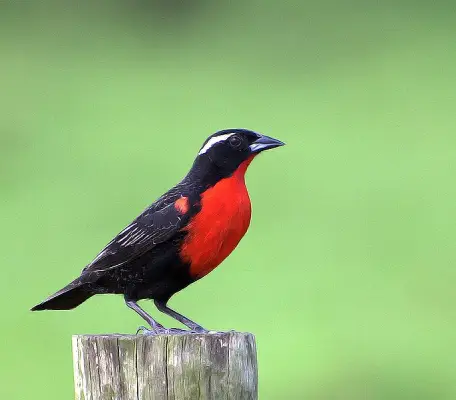
- Scientific name: Leistes superciliaris
- Lifespan: n/a
- Wingspan: n/a
- Color: Black with bright red on wings and chests
White-browed meadowlarks are medium-sized songbirds native to South America.
They were once named white-browed blackbirds due to their black and red plumage colors, but they are not closely related to the red-winged blackbird group.
They breed in Brazil and southern parts of South America and can be seen in open country, around wet grasslands and agricultural areas.
Male white-breasted meadowlarks are mainly black with bright red wing epaulets, throats, bellies, and white eyebrows. Females are mostly brown and streaky.
Their song consists of a series of notes that sound like “tzz-tee-chu-chu-chak” while the call is a short “chuck“.
White-browed meadowlarks are very social and often forage on the ground.
They are omnivores that consume insects and seeds.
They resemble red-breasted meadowlarks a lot with the main difference being the white eyebrows absent in red-breasted ones.
White-browed meadowlarks have an interesting courtship ritual where males fly 30 feet in the air and then drop down with folded wings and sing their buzzing song.
The pair will build an open cup nest on the ground and have a clutch of 3-5 pale blue eggs with reddish-brown markings.
Red-winged Starling
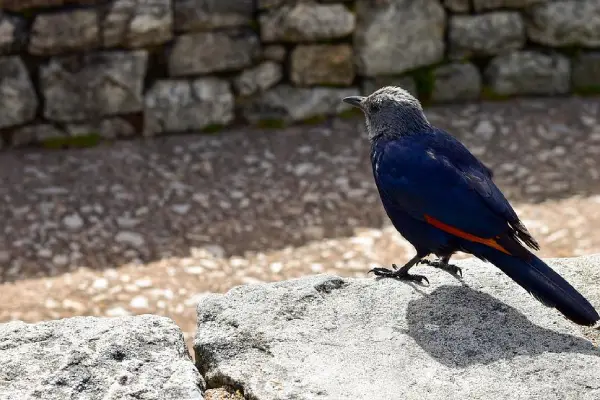
- Scientific name: Onychognathus morio
- Lifespan: n/a
- Wingspan: n/a
- Color: Glossy black-blue and red
Red-winged starlings are large birds native to eastern Africa.
They are common in forests, savannahs, grasslands, wetlands, farmlands, plantations, and urban areas.
Male red-winged starlings can be identified by their glossy black-blue plumage with bright chestnut-red primary wing feathers. Females have ash-gray plumage.
They can be also identified by several whistled calls with the most common being the contact “cher-leeeoo” call.
Source: Anne Ndung’u, CC BY-SA 4.0, via Wikimedia Commons
Highly gregarious outside of the breeding season, these black and red birds become very territorial and aggressive when nesting. They are known to attack other birds, even domestic animals, and humans.
Red-winged starlings will build their nests using grass, twigs, and mud and nest around cliffs. A female will lay 2-4 blue eggs that are spotted with red, twice per year.
A great spotted cuckoo will often kick this starling’s eggs and lay its own for the starling to raise (this is known as brood parasitism).
Red-winged starlings are omnivores. They feed on fruits, seeds, insects, mollusks, snails, spiders, and carrion, and forage on the ground, in trees, or bushes.
Wilson’s Bird Of Paradise
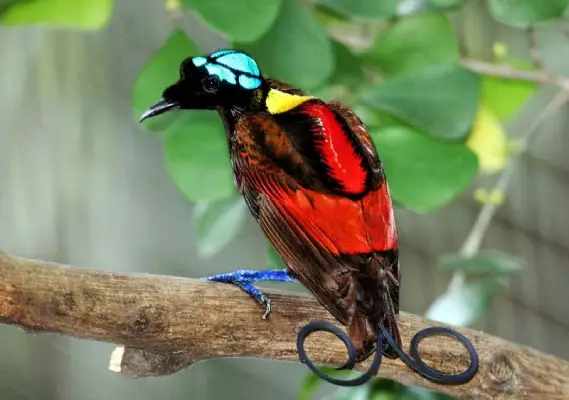
- Scientific name: Cicinnurus respublica
- Lifespan: n/a
- Wingspan: n/a
- Color: Black, red, blue, green, and yellow
Wilson’s bird-of-paradise is a unique and colorful perching bird native to Indonesia.
The species inhabits lowland rainforests on Waigeo and Batanta islands.
Male Wilson’s bird-of-paradise is black with red wings, a yellow neck mantle, and a blue head with a cross pattern. They also have two curved tail feathers. Females are more brownish.
They can be also identified in nature by a series of loud, down-slurred “piuu” calls.
These black birds with red wings are listed as Near Threatened by the IUCN due to increasing habitat loss.
Wilson’s bird-of-paradise is an omnivore that feeds on insects, spiders, small invertebrates, and fruits.
The specie was named by a French ornithologist, Charles Lucien Bonaparte, Napoleon’s nephew, after the British ornithologist Edward Wilson.
Ross’s Turaco
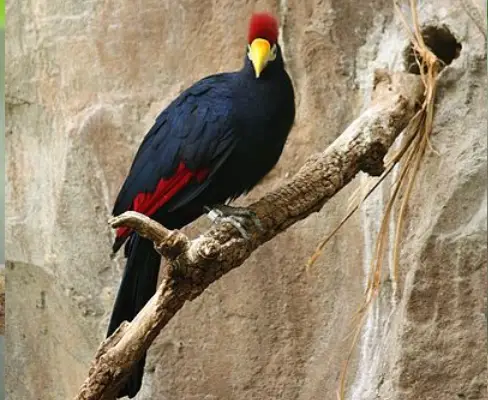
- Scientific name: Tauraco rossae
- Lifespan: 8-20 years
- Wingspan: n/a
- Color: Purple-black with red wings
Ross’s turacos, also known as Lady Ross’s turacos, are African birds found around woodlands, open forests, and riparian habitats.
They are the second largest of the turaco family and weigh around 1 pound and measure 15-18 inches in length.
Ross’s turacos are dark purple-black with bright red primary wing feathers and red crests.
They also have black legs with three forward-facing toes and bright yellow beaks. Their fourth toe is semi-zygodactylous and helps them grip and clamber through the tree canopy.
Ross’s turacos are very social and noisy birds that can form groups of up to 30 individuals. Their most common call is a loud crackling.
These birds are omnivores and feed on fruits, flowers, seeds, small insects like termites, and snails.
They are also monogamous and as part of the courtship ritual, males will feed the females. Both partners will build the nest and take turns in incubating their 2 eggs.
Fun Fact: Turacos are the only birds that have the true red color; in other birds, the color is the result of the light refraction produced by the feathers. Turacos, on the other hand, have a red pigment called turacin that contains copper, and that gives dark Ross’s turacos their unique red wing color.
Pesquet’s Parrot

- Scientific name: Psittrichas fulgidus
- Lifespan: 20-40 years
- Wingspan: n/a
- Color: Black and bright red
Pesquet’s parrots are large red and black parrots native to the rainforests of New Guinea.
They measure around 18 inches in length and weigh 24-28 ounces.
Pesquet’s parrots have black plumage with bright red wings, bellies, and rumps.
They also have bare black faces and long and hooked beaks giving them the nickname “vulturine parrots, ” which is one of their many.
Pesquet’s parrots are also known as Dracula’s parrots but do not follow Dracula’s diet. Instead, they are frugivores that mainly feed on several species of figs, some flowers, and nectar.
Pesquet’s parrots are usually seen in pairs or small groups of up to 20 birds.
Their stunning plumage makes them very prized among bird watchers; this in combination with habitat loss has placed them on the list of Vulnerable species.
They have very harsh and rasping calls that people describe as “growling”.
Fun Fact: Pesquet’s parrots are just one of three parrot species that have featherless faces. This is thought to be an adaptation to avoid feather-matting from eating sticky fruits.
Read More: List of black birds that have white color on their bellies
Greater Coucal
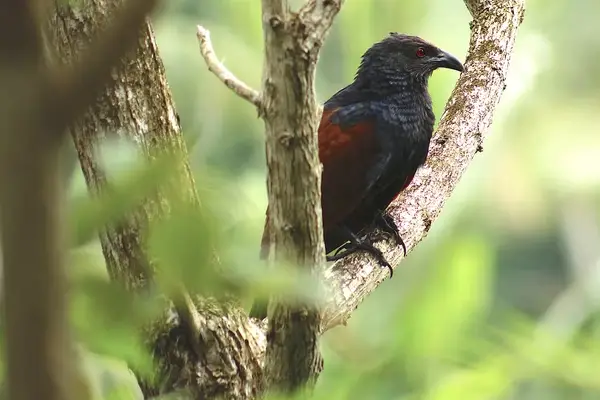
- Scientific name: Centropus sinensis
- Lifespan: n/a
- Wingspan: n/a
- Color: Black and brown-red
Greater coucals are large birds with black plumage, distinctive rusty brown-reddish wings, glossy underparts, long black tails, and deep red eyes.
Unlike other members of their cuckoo family, these birds do not display parasitic behavior and raise their own young.
Greater coucals are also known as crow pheasants and inhabit various areas, ranging from jungle to cultivation and urban gardens.
They are found in Southeast Asia and India and breed there from June to September.
They are monogamous, both partners build the nests, and females lay 3-5 white eggs with a yellow glaze.
Greater coucals’ most common call consists of a series of deep “oop-oop” sounds.
They are omnivores and feed on insects, caterpillars, bird eggs, fruits, and seeds.
Greater coucals aren’t the best fliers and will often hop on the ground in pursuit of the next meal.
If you enjoyed this article, make sure to check our list of black birds with yellow on their wings.
Summary
This concludes our list of black birds with red wings.
Examples of small black-colored birds with red wings include several types of blackbirds, meadowlarks, birds of paradise, turacos, and parrots.
Hopefully next time you see any of these birds, you will recognize them with ease!
And if you enjoyed our article, here’s another popular read on birds: List of black birds with white wings and List of black birds with orange beaks